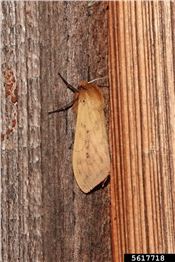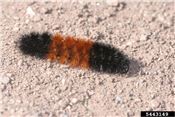What Says The Wooly Bear About Winter?
PRINCETON, KENTUCKY
Now that summer is winding down, things like pumpkin spice, Halloween costumes, and hoodies may start appearing. Conversations may also start to turn toward predictions regarding the upcoming winter. A quick Google search reveals that there seems to be a negative anticipation about the 2022-2023 winter season, with some outlets predicting colder than average temperatures and possibly even higher than average amounts of snowfall. Though only time will tell if these models and predictions come true, others may turn to an unexpected meteorologist when prognosticating about the winter: the humble woolly bear caterpillar.
What is a woolly bear?
The woolly bear is also known as a woolly worm as a larva. They are a part of a group of moths known as “tiger moths.” The specific weather predicting species is Pyrrharctia Isabella, also known as the Isabella tiger moth. The adult form of the moth is a pale orange/light brown when the wings are closed. There can be broken black dots and lines on the wings as well. This species exhibits sexual dimorphism, which can be seen when the wings are open for flight. Isabella tiger moth females have slightly rosy hindwings, while males have pale orange hindwings.
The larval form is undoubtedly the more famous stage of their life cycle. They overwinter as caterpillars and can be found first in the spring. These winter warriors will pupate and become adults, laying eggs that will hatch into the next generation of caterpillars, which are seen as summer ends. While they are hairy throughout their lives, they don’t develop the thicker furry coat with bands of black and orange until almost completely grown. The larval stage is known to feed on a variety of plants, including grasses and clover, as well as sunflowers, milkweed, corn, maples, and birches. They aren’t normally considered a significant pest though.
When they pupate, the hairs from their body are incorporated into a cocoon that helps protect the pupal form. If you have ever looked under a log and found what looks like a webby hairball, it could have been a wooly bear inside there developing into an adult moth.
Where does weather prediction come in?
Folk wisdom holds that the woolly bear can be an indicator for upcoming winter weather when caterpillars are found in the autumn.
There are two methods of prediction that can be employed. In the first, looking at the caterpillars for the relative amount of black hair versus orange hair will demonstrate how drastic winter might be.
The more black hair compared to orange, the worse winter will be. A more analytical version of this folk wisdom is that the 13 body segments of the caterpillar represent the 13 weeks of winter. Looking at where black versus orange appears can tell when winter will be at its worst on the calendar.
Others believe that the direction the caterpillars are crawling can predict the weather. If they are heading south, then Old Man Winter has the worst in store for us.
Does it work?
It may not surprise anyone to hear that this particular method of winter foretelling has been found inaccurate. No correlation has been found between caterpillar color form and the severity of winter.
Woolly bears can be highly variable in their coloration, not only year- from-year, but caterpillar-to-caterpillar.
Even though they won’t be hired by the Weather Channel anytime soon, woolly bears do have a unique connection to winter. As mentioned before, the caterpillar is the overwintering stage of this moth species. This is fairly unique as many moths would overwinter as an egg or as a pupa, both inactive life stages that can safely hide away from chilly temps. Woolly bears survive the winter by finding an out of the way spot to hide from cold air temperatures. Further, they produce glycerol, an antifreeze like chemical, which can allow them to be super cooled to subzero temperatures for extended periods of time and still survive. So, even if they can’t tell us how cold the upcoming months may be, they will be prepared for the worst!
In Kentucky, we can celebrate this unique and beloved caterpillar at the Woolly Worm Festival, held in Lee County October 21-23 this year.
If you go, be sure to check out the woolly worm race! ∆

Figure 1: Adult woolly bears are called Isabella tiger moths, and they are a pale orange color when viewed with the wings closed. The moths are usually seen in the late spring/early summer.
Photo: Rebekah D. Wallace, University of Georgia, Bugwood.org

Figure 2: Wooly bear caterpillars are known for a black and brown banding pattern to their “fur.”
Folk wisdom tells us that these hairs may help when predicting winter weather.
Photo: Whitney Cranshaw, Colorado State University, Bugwood.org